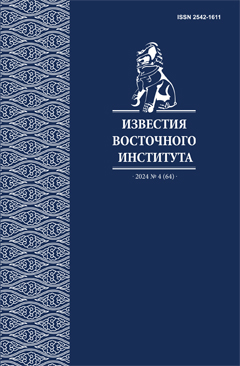Economic interaction mechanisms of the Northeast Asia countries
DOI:
https://doi.org/10.24866/2542-1611/2024-4/114-128Keywords:
trade in goods and services, foreign direct investment, barriers, integration format, cooperation agreement, China, Japan, Republic of Korea, Russia, Mongolia, DPRKAbstract
The mechanisms of trade and investment interaction in North-East Asia (NEA) are shown. The difficulties in creating CJK FTA between the have been identified, caused by the lack of consensus between Japan on the one hand and China and the Republic of Korea on the other. At the same time, Japan, China and the Republic of Korea have made significant progress in reducing barriers to investment integration. It was revealed that the Republic of Korea was very active in creating integration formats with foreign countries to access the world's largest markets. The reasons for the lack of motivation for Russia and Mongolia to reduce barriers with the NEA countries are indicated. The specifics of the DPRK economy, which hinder the expansion of international trade and investment cooperation, are shown.
Downloads
References
Асмолов К.В., Захарова Л.В. Современная Северная Корея: первое десятилетие эпохи Ким Чен Ына (2012–2021). М.: ИКСА РАН, 2022. 440 с.
Изотов Д.А. Генезис политики экономических взаимодействий России со странами АТР: случай Дальнего Востока // Проблемы Дальнего Востока. 2021. № 2. C. 124-137. doi: dx.doi.org/10.31857/S013128120014753-9
Изотов Д.А. Интеграция российской экономики со странами АТР: возможности и риски // Известия ДВФУ. Экономика и управление. 2022. №2. С.28–47. doi: dx.doi.org/10.24866/2311-2271/2022-2/28-47
Brooks D.H., Fan E.X., Sumulong L.R. Foreign Direct Investment: Trends, TRIMs, and WTO Negotiations // Asian Development Review. 2003. Vol.20. No. 1. P.1–33. doi: doi.org/10.1142/S0116110503000010
Choi J. North Korea’s Tariff and Non-tariff System: Implications for Integration into the International Economy // World Economy Brief. September 6, 2024. Vol. 14 No. 29. https://www.kiep.go.kr/gallery.es?mid=a20301000000&bid=0007&list_no=11475&act=view (дата обращения: 15.09.2024).
Choi Y. Political economy of free trade agreements in China, Japan, and South Korea: sectoral politics of the FTA wave, 1998–2016 // Japanese Journal of Political Science. 2020. Vol.21. P.145–157. doi: doi.org/10.1017/S1468109920000031
Choi Y. The Optimal Path of a China–Japan–Korea FTA: Multilateral Path or Sequential Path? // Pacific Focus. 2013. Vol. 28. No. 3. P. 435–458. doi: doi.org/10.1111/pafo.12018
Cieślik A., Gurshev O. Factor Endowments, Economic Integration, Sanctions, and Offshores: Evidence from Inward FDI in Russia // Comparative Economic Studies. 2023. Vol.65. P.617–649. doi: doi.org/10.1057/s41294-022-00202-6
Corning G.P. CJK Investment Agreements in East Asia: Building a Bifurcated Investment Regime // Asian Politics & Policy. 2014. Vol.6. No. 2. P.285–306. doi: doi.org/10.1111/aspp.12111
Damgaard J., Elkjaer T., Johannesen N. What Is Real and What Is Not in the Global FDI Network? / IMF. Working Paper No. 19/274. 2019. URL: https://www.imf.org/en/Publications/WP/Issues/2019/12/11/whatis-real-and-what-is-not-in-the-global-fdi-network (дата обращения: 15.09.2024).
Ederington J., Ruta M. Nontariff Measures and the World Trading System // Handbook of Commercial Policy. Volume 1B / Ed. by K. Bagwell, R.W. Staiger. North Holland, 2016. P.211–277. doi: doi.org/10.1016/bs.hescop.2016.04.010
Foreign direct investment: Inward and outward flows and stock / UNCTAD. URL: https://unctadstat.unctad.org/datacentre/dataviewer/US.FdiFlowsStock (дата обращения: 15.09.2024).
International Investment Agreements Navigator / UNCTAD. URL: https://investmentpolicy.unctad.org/international-investment-agreements/by-economy (дата обращения: 15.09.2024).
Jackson K., Shepotylo O. Transforming East Asia: Regional Integration in a Trade War Era // Open Economies Review. 2023. Vol. 34. P. 657–672. doi: doi.org/10.1007/s11079-022-09698-y
Jargalsaikhan T., Tuvshintugs M.-E., Park E.B. An Analysis of Foreign Direct Investment Flows into Mongolia // Oikonomos. 2021. Vol. 7. No. 1. P.29–48.
Jiang H., Yu M. Understanding RCEP and CPTPP: from the perspective China’s dual circulation economic strategy // China Economic Journal. 2021. Vol.14. No. 2. P.144–161. doi: doi.org/10.1080/17538963.2021.193 3055
Kim J., Kim K., Park S., Sun C. The economic costs of trade sanctions: Evidence from North Korea // Journal of International Economics. 2023. Vol.145. P.103813. doi: doi.org/10.1016/j.jinteco.2023.103813.
Kriebitz A., Max R. Foreign direct investment liberalization in communist regimes: a theoretical model based on the comparison among China, Cuba, North Korea, and Vietnam // Political Studies Review. 2022. Vol.20. No. 3. P.456–474. doi: doi.org/10.1177/14789299211020911
Naranbold B., Kim E.-M. A Study on FTA Partner Selection: A Focus on a Land Locked Developing Country, Mongolia // Journal of International Trade & Commerce. 2019. Vol.15. No. 2. P.95–116. doi: dx.doi.org/10.16980/jitc.15.2.201904.95
Pekkanen S. Investment regionalism in Asia: new directions in law and policy? // World Trade Review. 2012. Vol.11. P.119–154. doi: doi.org/10.1017/S1474745611000383
Plummer M.G. Best Practices In Regional Trading Arrangements: An Application to Asia // The World Economy. 2007. Vol.30. No. 12. P. 1771–1796. doi: doi.org/10.1111/j.1467-9701.2007.01061.x
Regional Trade Agreements Database / WTO. URL: https://rtais.wto.org/UI/publicPreDefRepByCountry.aspx (дата обращения: 15.09.2024).
Scalapino R.A. The Politics of Development: Perspectives on Twentieth Century Asia. Cambridge, Massachusetts, Harvard University Press, 1989. 137 p.
Statistics Data centre / UNCTADstat. URL: https://unctadstat.unctad.org/datacentre/ (дата обращения: 15.09.2024).
Tabata S. Economic Integration in Northeast Asia from the 1990s // Geo-Politics in Northeast Asia / Ed. by Iwashita, Y.-C. Ha, E. Boyle. London, Routledge, 2022. P.171–183. doi: doi.org/10.4324/9781003288039-13
Tariff data by Country / World Bank. URL: https://wits.worldbank.org/tariff/trains/country-byhs6product.aspx?lang=en (дата обращения: 15.09.2024).
Terada T. Northeast Asia’s Realism: Fated External Influences on Trilateral Economic Integration // East Asian Community Review. 2018. Vol.1. P.49–59. doi: doi.org/10.1057/s42215-018-0006-4
Tokunaga M., Suganuma K. Japan’s foreign direct investment in Russia: a big return from a small opportunity // Eurasian Geography and Economics. 2020. Vol. 61. No. 3. P. 240–265. doi: doi.org/10.1080/1538-7216.2020.1716820
Types of Tariffs / World Bank URL: https://wits.worldbank.org/wits/wits/witshelp/content/data_retrieval/p/intro/c2.types_of_tariffs (дата обращения: 15.09.2024).
Unlocking the Potential for East and North-East Asian Regional Economic Cooperation and Integration. United Nations publication, 2017. URL: https://repository.unescap.org/handle/20.500.12870/3129 (дата обращения: 15.09.2024).
Yu H. Infrastructure connectivity and regional economic integration in East Asia: Progress and Challenges // Journal of Infrastructure, Policy and Development. 2017. Vol.1. No. 1. P.44–63. doi: doi.org/10.24294/jipd.v1i1.21
Zhang M. The China–Japan–Korea Trilateral Free Trade Agreement: Why Did Trade Negotiations Stall? // Pacific Focus. 2019. Vol. 34. No. 2. P. 204–229. doi: doi.org/10.1111/pafo.12142.




